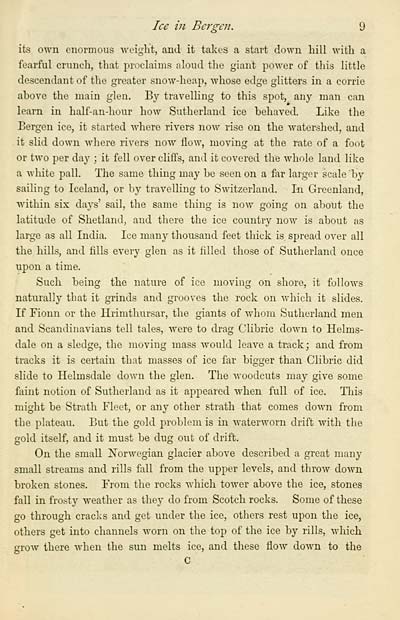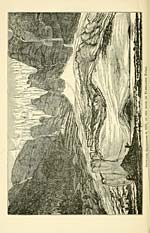Download files
Complete book:
Individual page:
Thumbnail gallery: Grid view | List view

Ice in Bcrsren.
its own enormous -weight, and it takes a start down liill with a
fearful crunch, that proclaims aloud the giant power of this little
descendant of the greater snow-heap, whose edge glitters in a corrie
above the main glen. By travelling to this spot, any man can
learn in half-an-hour how Sutherland ice behaved. Like the
Bergen ice, it started where rivers now rise on the watershed, and
it slid down where rivers now flow, moving at the rate of a foot
or two per day ; it fell over cliffs, and it covered the whole land like
a white pall. The same thing may be seen on a far larger scale by
sailing to Iceland, or by travelling to Switzerland. In Greenland,
within six days' sail, the same thing is now going on about the
latitude of Shetland, and there the ice country now is about as
large as all India. Ice many thousand feet thick is, spread over all
the hills, and fills every glen as it filled those of Sutherland once
upon a time.
Such being the nature of ice moving on shore, it follows
naturally that it grinds and grooves the rock on which it slides.
If Fionn or the Hrimthursar, the giants of whom Sutherland men
and Scandinavians tell tales, were to drag Clibric down to Helms-
dale on a sledge, the moving mass would leave a track; and from
tracks it is certain that masses of ice far bigger than Clibric did
slide to Helmsdale down the glen. The woodcuts may give some
faint notion of Sutherland as it appeared when full of ice. This
might be Strath Fleet, or any other strath that comes down from
the plateau. But the gold problem is in waterworn drift with the
gold itself, and it must be dug out of drift.
On the small Norwegian glacier above described a great many
small streams and rills fall from the upper levels, and throw down
broken stones. From the rocks which tower above the ice, stones
fall in frosty weather as they do from Scotch rocks. Some of these
go through cracks and get under the ice, others rest upon the ice,
others get into channels worn on the top of the ice by rills, which
grow there when the sun melts ice, and these flow down to the
C
its own enormous -weight, and it takes a start down liill with a
fearful crunch, that proclaims aloud the giant power of this little
descendant of the greater snow-heap, whose edge glitters in a corrie
above the main glen. By travelling to this spot, any man can
learn in half-an-hour how Sutherland ice behaved. Like the
Bergen ice, it started where rivers now rise on the watershed, and
it slid down where rivers now flow, moving at the rate of a foot
or two per day ; it fell over cliffs, and it covered the whole land like
a white pall. The same thing may be seen on a far larger scale by
sailing to Iceland, or by travelling to Switzerland. In Greenland,
within six days' sail, the same thing is now going on about the
latitude of Shetland, and there the ice country now is about as
large as all India. Ice many thousand feet thick is, spread over all
the hills, and fills every glen as it filled those of Sutherland once
upon a time.
Such being the nature of ice moving on shore, it follows
naturally that it grinds and grooves the rock on which it slides.
If Fionn or the Hrimthursar, the giants of whom Sutherland men
and Scandinavians tell tales, were to drag Clibric down to Helms-
dale on a sledge, the moving mass would leave a track; and from
tracks it is certain that masses of ice far bigger than Clibric did
slide to Helmsdale down the glen. The woodcuts may give some
faint notion of Sutherland as it appeared when full of ice. This
might be Strath Fleet, or any other strath that comes down from
the plateau. But the gold problem is in waterworn drift with the
gold itself, and it must be dug out of drift.
On the small Norwegian glacier above described a great many
small streams and rills fall from the upper levels, and throw down
broken stones. From the rocks which tower above the ice, stones
fall in frosty weather as they do from Scotch rocks. Some of these
go through cracks and get under the ice, others rest upon the ice,
others get into channels worn on the top of the ice by rills, which
grow there when the sun melts ice, and these flow down to the
C
Set display mode to: Large image | Transcription
Images and transcriptions on this page, including medium image downloads, may be used under the Creative Commons Attribution 4.0 International Licence unless otherwise stated. ![]()
| Early Gaelic Book Collections > J. F. Campbell Collection > Something from the gold diggings in Sutherland > (11) |
|---|
| Permanent URL | https://digital.nls.uk/82033562 |
|---|
| Description | Volumes from a collection of 610 books rich in Highland folklore, Ossianic literature and other Celtic subjects. Many of the books annotated by John Francis Campbell of Islay, who assembled the collection. |
|---|
| Description | Selected items from five 'Special and Named Printed Collections'. Includes books in Gaelic and other Celtic languages, works about the Gaels, their languages, literature, culture and history. |
|---|

